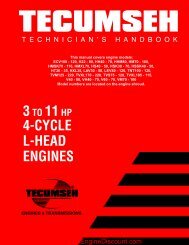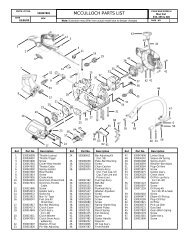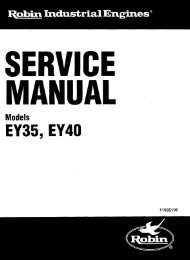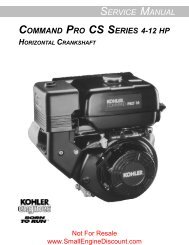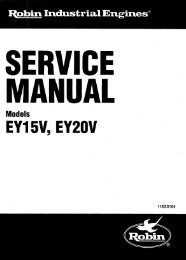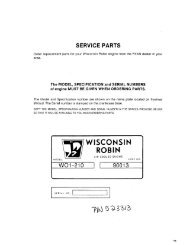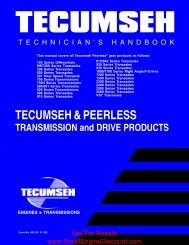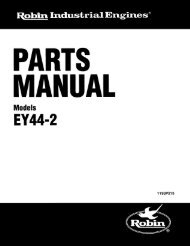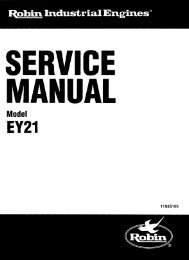4-CYCLE OVERHEAD VALVE ENGINES - Small Engine Discount
4-CYCLE OVERHEAD VALVE ENGINES - Small Engine Discount
4-CYCLE OVERHEAD VALVE ENGINES - Small Engine Discount
Create successful ePaper yourself
Turn your PDF publications into a flip-book with our unique Google optimized e-Paper software.
TESTING PROCEDURE<br />
STARTING CIRCUIT<br />
1. Check the power source using an electrical tester and following the tester's recommended procedure.<br />
Make sure the battery meets the minimum battery voltage requirements found in the original equipment<br />
manufacturer's service manual.<br />
2. Check the electric starter terminal for the required voltage (12v D.C. or 120v A.C.) using a voltmeter.<br />
CAUTION: FOLLOW ALL SAFETY PRECAUTIONS WHEN TESTING FOR A.C. VOLTAGE, ELECTRIC<br />
SHOCK CAN KILL.<br />
3. Check wiring, connections, fuses, ignition or starter switch, safety switches, or solenoid for continuity<br />
using a ohmmeter or a continuity light. Repair or replace as necessary.<br />
4. Remove all equipment loads from the engine. Take off all drive belts, chains, and couplers to isolate<br />
the engine from the equipment it is powering.<br />
5. Try to turn the engine over using the recoil assembly if equipped. If the engine doesn’t turn over, a<br />
mechanical binding may be the cause. Check for proper lubrication (oil level and viscosity) and check<br />
for electric starter gear and flywheel ring gear interference. If no problem is discovered, the problem is<br />
an internal failure.<br />
6. If the engine binds only on the compression stroke, check the engine valve clearance per the<br />
specification table in Chapter 10. If the valve clearance is within the specifications, the camshaft<br />
(compression release failure) may require replacement. Valve clearance not within the listed<br />
specifications will require resetting the rocker arms to obtain the proper clearance.<br />
7. If the engine turns over freely, the electric starter should be replaced or disassembled and checked.<br />
See "Service" in this chapter. 120 volt starters labeled UL Listed/CSA Approved can be serviced;<br />
however, starters labeled CSA must only be replaced. If the preceding steps fail to correct the problem,<br />
the engine will require to be disassembled to find the mechanical failure. See Chapter 9 under<br />
"Disassembly Procedure".<br />
CHARGING CIRCUIT<br />
The following pages will show wiring diagrams of several Tecumseh charging systems. The charging system<br />
used on the engine is best identified by obtaining the engine model number and the specification number on<br />
the engine. Consult a Tecumseh dealer or a parts manual to identify the charging system. To make many of the<br />
tests it is necessary to run the engine and measure alternator output with a voltmeter. When making voltage<br />
tests with the engine running, it is not necessary to take readings at all the listed R.P.M.s. Checking at one of<br />
the speeds is sufficient.<br />
In some cases an open circuit D.C. check cannot be<br />
made. A SCR (Silicon Controlled Rectifier) is located<br />
in the circuit which requires a minimum “turn on”<br />
voltage to allow it to conduct. Without the battery in<br />
the circuit this “turn on” voltage is not present. The<br />
SCR “senses” this and there will be no D.C. output<br />
from the regulator / rectifier.<br />
Each charging system has its own testing procedure.<br />
Test the charging system using the applicable<br />
procedure found on the following pages.<br />
350 Milliamp Charging System<br />
CHECKING THE SYSTEM: The battery must be in<br />
the circuit to perform the test properly. Set the<br />
voltmeter to the 0 - 20 D.C. volt scale. Connect a<br />
voltmeter across the battery. The voltmeter should<br />
read the battery voltage. Start the engine. With the<br />
engine running, there should be an increase in the<br />
voltage reading. If there is no change in the voltage<br />
reading, the alternator is defective and should be<br />
replaced. See Chapter 9 for "Disassembly Procedure"<br />
(diag. 7).<br />
40<br />
MAGNETO GROUND<br />
(GR)<br />
(-) ENGINE GROUND<br />
BATTERY GROUND (BL)<br />
RED<br />
BLACK<br />
D.C. OUTPUT<br />
LEAD (RED)<br />
Not For Resale<br />
www.<strong>Small</strong><strong>Engine</strong><strong>Discount</strong>.com<br />
(+) POSITIVE LEAD<br />
ELECTRIC STARTER<br />
LEAD (ORG)<br />
7




